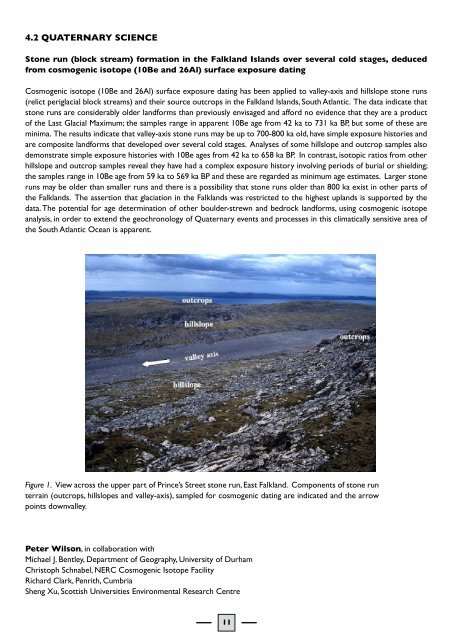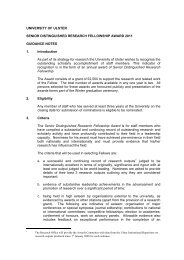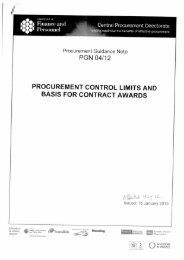environmental sciences research institute - University of Ulster
environmental sciences research institute - University of Ulster
environmental sciences research institute - University of Ulster
Create successful ePaper yourself
Turn your PDF publications into a flip-book with our unique Google optimized e-Paper software.
4.2 QUATERNARY SCIENCE<br />
Stone run (block stream) formation in the Falkland Islands over several cold stages, deduced<br />
from cosmogenic isotope (10Be and 26Al) surface exposure dating<br />
Cosmogenic isotope (10Be and 26Al) surface exposure dating has been applied to valley-axis and hillslope stone runs<br />
(relict periglacial block streams) and their source outcrops in the Falkland Islands, South Atlantic. The data indicate that<br />
stone runs are considerably older landforms than previously envisaged and afford no evidence that they are a product<br />
<strong>of</strong> the Last Glacial Maximum; the samples range in apparent 10Be age from 42 ka to 731 ka BP, but some <strong>of</strong> these are<br />
minima. The results indicate that valley-axis stone runs may be up to 700-800 ka old, have simple exposure histories and<br />
are composite landforms that developed over several cold stages. Analyses <strong>of</strong> some hillslope and outcrop samples also<br />
demonstrate simple exposure histories with 10Be ages from 42 ka to 658 ka BP. In contrast, isotopic ratios from other<br />
hillslope and outcrop samples reveal they have had a complex exposure history involving periods <strong>of</strong> burial or shielding;<br />
the samples range in 10Be age from 59 ka to 569 ka BP and these are regarded as minimum age estimates. Larger stone<br />
runs may be older than smaller runs and there is a possibility that stone runs older than 800 ka exist in other parts <strong>of</strong><br />
the Falklands. The assertion that glaciation in the Falklands was restricted to the highest uplands is supported by the<br />
data. The potential for age determination <strong>of</strong> other boulder-strewn and bedrock landforms, using cosmogenic isotope<br />
analysis, in order to extend the geochronology <strong>of</strong> Quaternary events and processes in this climatically sensitive area <strong>of</strong><br />
the South Atlantic Ocean is apparent.<br />
Figure 1. View across the upper part <strong>of</strong> Prince’s Street stone run, East Falkland. Components <strong>of</strong> stone run<br />
terrain (outcrops, hillslopes and valley-axis), sampled for cosmogenic dating are indicated and the arrow<br />
points downvalley.<br />
Peter Wilson, in collaboration with<br />
Michael J. Bentley, Department <strong>of</strong> Geography, <strong>University</strong> <strong>of</strong> Durham<br />
Christoph Schnabel, NERC Cosmogenic Isotope Facility<br />
Richard Clark, Penrith, Cumbria<br />
Sheng Xu, Scottish Universities Environmental Research Centre<br />
<br />
11
















